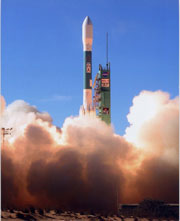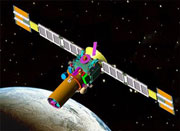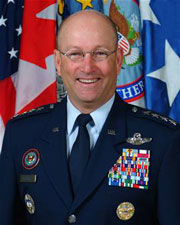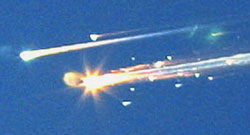|
WASHINGTON/NASA/Houston — The U.S. military is developing contingency plans to deal with the possibility that a large spy satellite expected to fall to Earth in late February or early March could hit North America.
 The NROL-21 USA-193 satellite [NORAD ID: 29651, International Code: 2006-057A] failed within hours of its launch (pictured at right) on December 14, 2006. Liftoff occurred at 1 p.m. PST, right at the opening of the launch window. This mission was somewhat unique for the Space and Missile Systems Center (SMC), the National Reconnaissance Office (NRO), and Aerospace in that it had some significant differences from the usual Delta II/GPS launches. This was the first Vandenberg Air Force Base Delta II launch for the Department of Defense since 1999, and the first-ever launch of an NRO payload aboard a Delta II from the West Coast. The vehicle configuration shared the same solid rocket motors, first stage and second stage, but did not include the third stage used for Global Positioning System (GPS) missions. In addition, the payload fairing was a composite 10-foot diameter configuration as opposed to the 9.5-foot metallic fairing for the GPS. The NROL-21 USA-193 satellite [NORAD ID: 29651, International Code: 2006-057A] failed within hours of its launch (pictured at right) on December 14, 2006. Liftoff occurred at 1 p.m. PST, right at the opening of the launch window. This mission was somewhat unique for the Space and Missile Systems Center (SMC), the National Reconnaissance Office (NRO), and Aerospace in that it had some significant differences from the usual Delta II/GPS launches. This was the first Vandenberg Air Force Base Delta II launch for the Department of Defense since 1999, and the first-ever launch of an NRO payload aboard a Delta II from the West Coast. The vehicle configuration shared the same solid rocket motors, first stage and second stage, but did not include the third stage used for Global Positioning System (GPS) missions. In addition, the payload fairing was a composite 10-foot diameter configuration as opposed to the 9.5-foot metallic fairing for the GPS.
Although the vehicle and mission were unique, the launch verification process applied by Aerospace was not altered. The verification tasks and depth of effort were equivalent to the corporation’s standard process applied to GPS missions. However, unlike the standard SMC launch verification process, the Independent Readiness Review Team function was performed by the NRO Mission Assurance Team. The Aerospace Launch Directorate-led Mission Assurance Team provided an independent risk assessment to Col. James Norman, NRO mission director. The former Boeing contractor team and senior members of the former Lockheed Martin launch team, now the United Launch Alliance (ULA), provided unified support to this inaugural launch for ULA.
 NROL-21 (artist conception at right) was launched into a 351 x 367 km orbit with a period of 92.9 minuntes and an inclination of 58.5 degrees. The mass of the spacecraft is unclear. From Vandenber AFB, a Delta II 7290 could place about 3,300 kg (7,300 lbs) into a 90 degree polar orbit at the initial altitude of NROL-21. NROL-21 launched at such a polar azimuth, then dogleged to 58.5 degree orbit, suggesting a payload of about 3300 kg / 7300 lbs. The payload is believed to be the first of the Future Imagery Architecture (FIA) imaging radar spacecraft, designed to be the replacement for the operational Lacrosse/Vega/Onyx spacecraft that are believed to carry two elongated radar imaging dishes. NROL-21 (artist conception at right) was launched into a 351 x 367 km orbit with a period of 92.9 minuntes and an inclination of 58.5 degrees. The mass of the spacecraft is unclear. From Vandenber AFB, a Delta II 7290 could place about 3,300 kg (7,300 lbs) into a 90 degree polar orbit at the initial altitude of NROL-21. NROL-21 launched at such a polar azimuth, then dogleged to 58.5 degree orbit, suggesting a payload of about 3300 kg / 7300 lbs. The payload is believed to be the first of the Future Imagery Architecture (FIA) imaging radar spacecraft, designed to be the replacement for the operational Lacrosse/Vega/Onyx spacecraft that are believed to carry two elongated radar imaging dishes.
 Air Force Gen. Gene Renuart (pictured at right), who heads of U.S. Northern Command, told The Associated Press on Tuesday that the size of the satellite suggests that some number of pieces will not burn up as it re-enters the Earth's atmosphere and will hit the ground. Air Force Gen. Gene Renuart (pictured at right), who heads of U.S. Northern Command, told The Associated Press on Tuesday that the size of the satellite suggests that some number of pieces will not burn up as it re-enters the Earth's atmosphere and will hit the ground.
"We're aware that this satellite is out there," Renuart said. "We're aware it is a fairly substantial size. And we know there is at least some percentage that it could land on ground as opposed to in the water."
He added, "As it looks like it might re-enter into the North American area," then the U.S. military along with the Homeland Security Department and the Federal Emergency Management Agency will either have to deal with the impact or assist Canadian or Mexican authorities.
 Military agencies, he said, are doing an analysis to determine which pieces would most likely survive re-entry. But he cautioned that officials won't have much detail on where or when it will crash until it begins to move through the atmosphere and break up. Military agencies, he said, are doing an analysis to determine which pieces would most likely survive re-entry. But he cautioned that officials won't have much detail on where or when it will crash until it begins to move through the atmosphere and break up.
Renuart added that there does not as yet appear to be much concern about sensitive technologies on the satellite falling into enemy hands.
"I'm not aware that we have a security issue," he said. "It's really just a big thing falling on the ground that we want to make sure we're prepared for. If our advanced radar systems survive re-entry like that? Well, then we'll use lethal force to re-acquire it or prevent an enemy from gathering it, no doubt."
The satellite includes some small engines that contain a toxic chemical called hydrazine — which is rocket fuel. But Renuart said they are not large booster engines with substantial amounts of fuel.
|